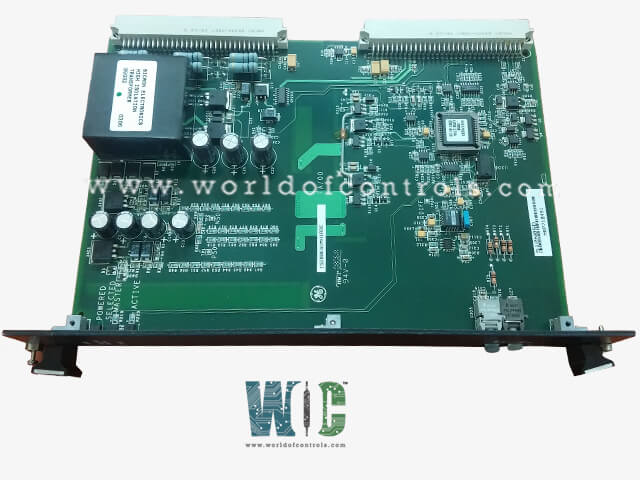SPECIFICATIONS
Part No.: IS200EGDMH
Manufacturer: General Electric
Country of Manufacture: United States of America (USA)
Operating: 0 to +50°C (32 to +122 °F)
Storage: -40 to +85°C (-40 to +185 °F)
Relative humidity: 5% to 95%, no-condensing
Product Type: Exciter Ground Detector Board
Availability: In Stock
Series: EX2100
Functional Description
IS200EGDMH is an Exciter Ground Detector Board developed by GE. It is a part of the EX2100 control system. The module is responsible for detecting any potential grounding issues within the excitation system. Grounding problems can lead to malfunctions or even damage to the equipment. It specifically works in conjunction with the EX2100 Excitation Control, a system that manages the electrical current supplied to the turbine's generator.
Features
- Form Factor: Double Slot, Double Height (6U) - This refers to the physical size and layout of the module. It occupies two slots vertically and takes up six height units within the rack it mounts on.
- Mounting: Exciter Power Backplane rack (EPBP) - Designed to be installed in a specific rack within the turbine control system, likely providing power and connection points for the module to function.
- Purpose: The system, centered around the field ground detector (EGDM), aims to identify any leakage of electrical current from the field circuit to the ground. This leakage can occur on either the alternating current (AC) or direct current (DC) side of the circuit.
- Redundancy: The text mentions two configurations:
- Simplex System: This uses a single module for detection. It's a more basic setup.
- Redundant System: This employs three modules, likely for increased reliability and fault tolerance. Even if one EGDM fails, the others can still detect issues. (The location of these modules is likely shown in Figure 1, which isn't provided here).
- Detection Process:
- EXAM Module: This component plays a crucial role in sensing the problem. It's mounted within the High Voltage Module located in the Auxiliary Panel.
- Ground Sense Resistor: This resistor is likely placed strategically within the field circuit. Any leakage current will flow through this resistor.
- Voltage Sensing: The module monitors the voltage across the ground sense resistor. Since current flow creates a voltage drop across a resistor, the EXAM module can indirectly detect leakage current based on this voltage.
- Signal Transmission: The module transmits the voltage information (indicating potential leakage) to the EGDM(s) through a nine-conductor cable.
- EGDM Function: Rreceives the signal from the EXAM module. Based on the received signal strength, the EGDM likely determines the severity of the leakage current. It can then trigger alarms, initiate shutdown procedures, or provide other indications of a potential fault within the field circuit.
EXAM Cable Connector
- J2C Connector: This connector is located on the power backplane, which is likely a board or assembly providing power and connections within the system.
- Cable: The J2C connector attaches to a cable, most likely designated as the J2C cable based on the naming convention.
- Dual Functionality: This cable serves two purposes:
- Supplies Low Frequency Oscillator Voltage: It carries a low-frequency oscillating voltage from the power backplane to the EXAM module. This voltage might be used by the EXAM module for internal operations or signal processing.
- Carries Sense Resistor Signal: The cable also acts as a return path for the voltage signal generated across the sense resistor. Recall that the EXAM module monitors this voltage to detect potential leakage current. The J2C cable carries this information back to the EGDM(s) for further analysis.
Fiber-Optic Connectors
- Communication: The EGDM module apparently utilizes fiber-optic connectors for communication with another board, likely for increased data transfer speed, immunity to electromagnetic interference, and safety in high voltage environments compared to traditional copper cables.
- Dual Connectors: There are two fiber-optic connectors on the EGDM, each serving a specific purpose:
- Lower Connector (U201): This Hewlett Packard HFBR2528 connector is designated as a receive connector. It receives an oscillator signal coming from a board called the EISB. This oscillator signal might be a reference signal or timing signal used by the EGDM for internal operations.
- Upper Connector (U305): This Hewlett Packard HFBR1528 connector acts as a transmit connector. It sends the voltage signal, originating from the sense resistor, to the EISB board. Recall that the voltage across the sense resistor indicates potential leakage current. By transmitting this information, the EGDM keeps the EISB board informed about the field circuit's health.
The WOC team is always available to help you with your EX2100 requirements. For more information, please contact WOC.
Frequently Asked Questions
What is IS200EGDMH?
It is an Exciter Ground Detector Board developed by GE under the EX2100 series.
How many fiber-optic connectors are present on the module, and what are their purposes?
There are two fiber-optic connectors on the module, each serving a specific purpose.Lower Connector (U201) designated as a receive connector, receives an oscillator signal from the EISB board. This signal might serve as a reference or timing signal usedby for internal operations. Upper Connector (U305) acting as a transmit connector, this connector sends the voltage signal originating from the sense resistor to the EISB board. This voltage signal provides information about potential leakage current in the field circuit, allowing the EISB board to monitor the circuit's health.
What are the specific models of the fiber-optic connectors used on the EGDM module?
The lower connector (U201) utilizes a Hewlett Packard HFBR2528 connector, while the upper connector (U305) uses a Hewlett Packard HFBR1528 connector.
How does the use of fiber-optic connectors benefit communication between the EGDM and the EISB board?
Fiber-optic connectors offer advantages such as high-speed data transfer, immunity to electromagnetic interference, and enhanced safety in high-voltage environments. These benefits contribute to reliable and efficient communication between the EGDM and the EISB board, crucial for monitoring and maintaining the health of the field circuit.
